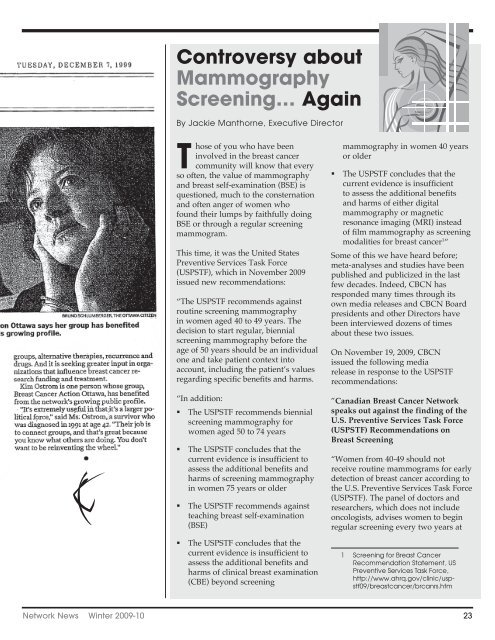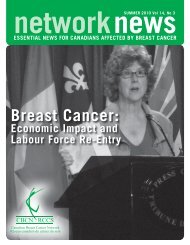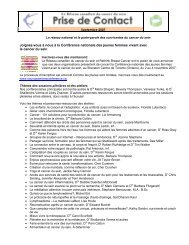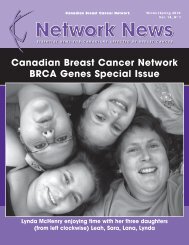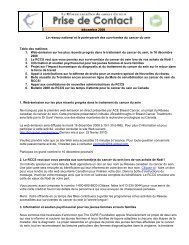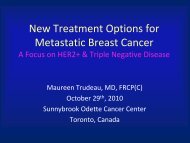Network News - Winter 2009/2010 (PDF 3.7Mb - Canadian Breast ...
Network News - Winter 2009/2010 (PDF 3.7Mb - Canadian Breast ...
Network News - Winter 2009/2010 (PDF 3.7Mb - Canadian Breast ...
You also want an ePaper? Increase the reach of your titles
YUMPU automatically turns print PDFs into web optimized ePapers that Google loves.
Controversy about<br />
Mammography<br />
Screening… Again<br />
By Jackie Manthorne, Executive Director<br />
Those of you who have been<br />
involved in the breast cancer<br />
community will know that every<br />
so often, the value of mammography<br />
and breast self-examination (BSE) is<br />
questioned, much to the consternation<br />
and often anger of women who<br />
found their lumps by faithfully doing<br />
BSE or through a regular screening<br />
mammogram.<br />
This time, it was the United States<br />
Preventive Services Task Force<br />
(USPSTF), which in November <strong>2009</strong><br />
issued new recommendations:<br />
“The USPSTF recommends against<br />
routine screening mammography<br />
in women aged 40 to 49 years. The<br />
decision to start regular, biennial<br />
screening mammography before the<br />
age of 50 years should be an individual<br />
one and take patient context into<br />
account, including the patient’s values<br />
regarding specific benefits and harms.<br />
“In addition:<br />
• The USPSTF recommends biennial<br />
screening mammography for<br />
women aged 50 to 74 years<br />
• The USPSTF concludes that the<br />
current evidence is insufficient to<br />
assess the additional benefits and<br />
harms of screening mammography<br />
in women 75 years or older<br />
• The USPSTF recommends against<br />
teaching breast self-examination<br />
(BSE)<br />
• The USPSTF concludes that the<br />
current evidence is insufficient to<br />
assess the additional benefits and<br />
harms of clinical breast examination<br />
(CBE) beyond screening<br />
mammography in women 40 years<br />
or older<br />
• The USPSTF concludes that the<br />
current evidence is insufficient<br />
to assess the additional benefits<br />
and harms of either digital<br />
mammography or magnetic<br />
resonance imaging (MRI) instead<br />
of film mammography as screening<br />
modalities for breast cancer 1 “<br />
Some of this we have heard before;<br />
meta-analyses and studies have been<br />
published and publicized in the last<br />
few decades. Indeed, CBCN has<br />
responded many times through its<br />
own media releases and CBCN Board<br />
presidents and other Directors have<br />
been interviewed dozens of times<br />
about these two issues.<br />
On November 19, <strong>2009</strong>, CBCN<br />
issued the following media<br />
release in response to the USPSTF<br />
recommendations:<br />
”<strong>Canadian</strong> <strong>Breast</strong> Cancer <strong>Network</strong><br />
speaks out against the finding of the<br />
U.S. Preventive Services Task Force<br />
(USPSTF) Recommendations on<br />
<strong>Breast</strong> Screening<br />
“Women from 40-49 should not<br />
receive routine mammograms for early<br />
detection of breast cancer according to<br />
the U.S. Preventive Services Task Force<br />
(USPSTF). The panel of doctors and<br />
researchers, which does not include<br />
oncologists, advises women to begin<br />
regular screening every two years at<br />
1 Screening for <strong>Breast</strong> Cancer<br />
Recommendation Statement, US<br />
Preventive Services Task Force,<br />
http://www.ahrq.gov/clinic/uspstf09/breastcancer/brcanrs.htm<br />
<strong>Network</strong> <strong>News</strong> <strong>Winter</strong> <strong>2009</strong>-10 23


